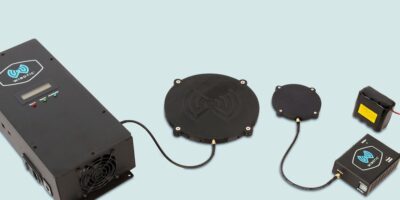Robot drones use wireless charging to extend battery life
Seattle-based WiBotic has developed wireless charging and power optimisation for robot fleets. The autonomous system uses Vicor’s 48V VI Chip PRM regulator to power the adaptive matching transmitter onboard the WiBotic TR-110 wireless charging station, which feeds power wirelessly to the robot’s or unmanned vehicle’s (UV’s) onboard receiver. The 400W high-efficiency VI Chip PRM operates from a 36 to 75V input to generate a regulated output. The PRM accepts 48V from an AC/DC power supply and the output voltage is adaptively controlled and trimmed from approximately 20 to 55V.
According to Vicor, the VI Chip PRM regulator power module neutralises thermal management constraints, enabling adaptive-matching transmitter for any battery, any robot and any station.
The demand for more efficient and flexible charging solutions for robotic fleets is increasing yet it is becoming less feasible to recharge them for use 24/7.
WiBotic’s wireless charging and power optimisation for aerial, mobile, marine and industrial robots enable them to be recharged through wireless charging stations, eliminating the need for human operators to physically connect the robots to chargers. Wireless charging reduces wear and tear on physical connection points, eliminates trip hazards from power cords and floor-mounted charging stations, and eliminates the requirement for dedicated charging areas, points out Vicor.
WiBotic wireless charging solutions are designed to facilitate “many-to-many” charging, whereby multiple robots (which can be from different manufacturers) can charge from the same transmitter at different times. Alternatively, an entire fleet of robots can move between a network of transmitters in different locations within a warehouse. It means any robot can charge from any station, even if different battery chemistries, voltages and charging currents are involved.
The Vicor PRM enables consistent, high efficiency conversion across the full range of impedances, flexibly supporting full charge and trickle charge modes with no significant drop-off in efficiency at lower power levels. According to Vicor, competing power components fail to achieve this benchmark. The conversion capability yielded a tightly consistent, maximum device temperature of 40 to 45 degrees C, helping to neutralise thermal management constraints across the full power range.
Vicor designs, develops, manufactures and markets modular power components and complete power systems based upon a portfolio of patented technologies. Headquartered in Andover, Massachusetts, Vicor sells its products to the power systems market, including enterprise and high-performance computing, industrial equipment and automation, telecommunications and network infrastructure, vehicles and transportation, aerospace and defense.




